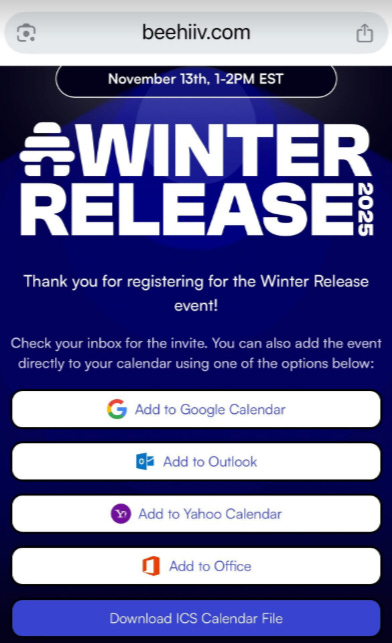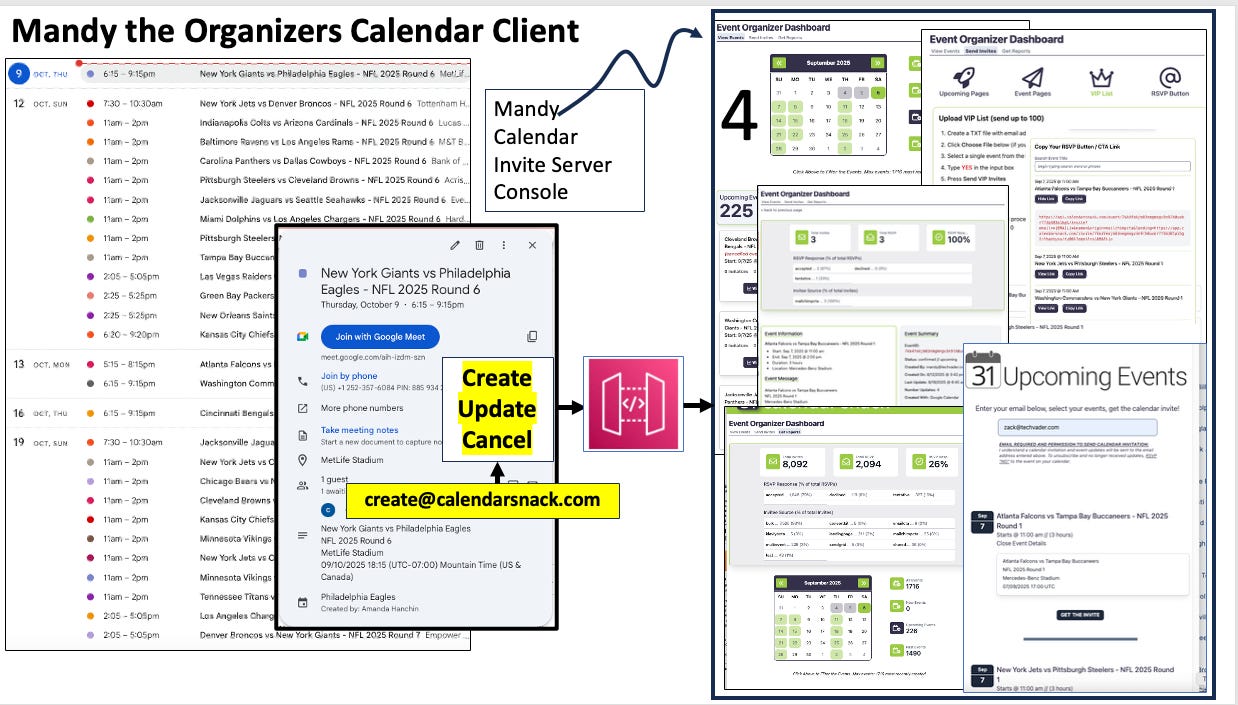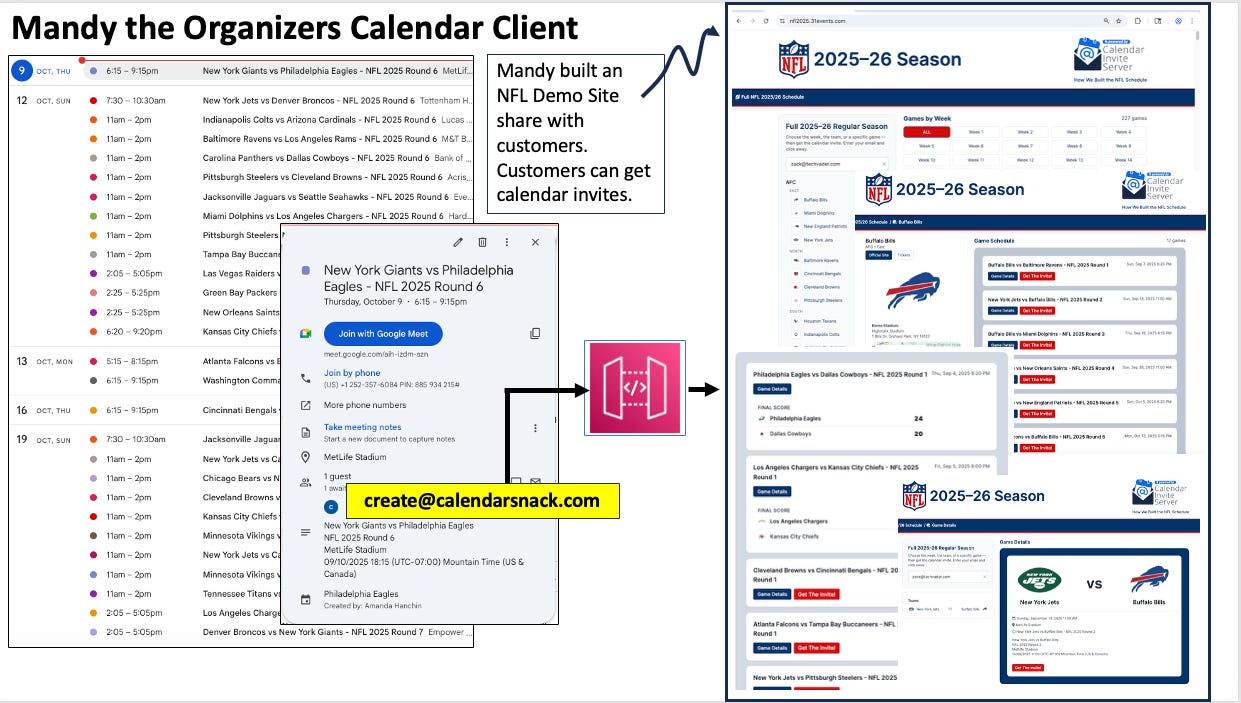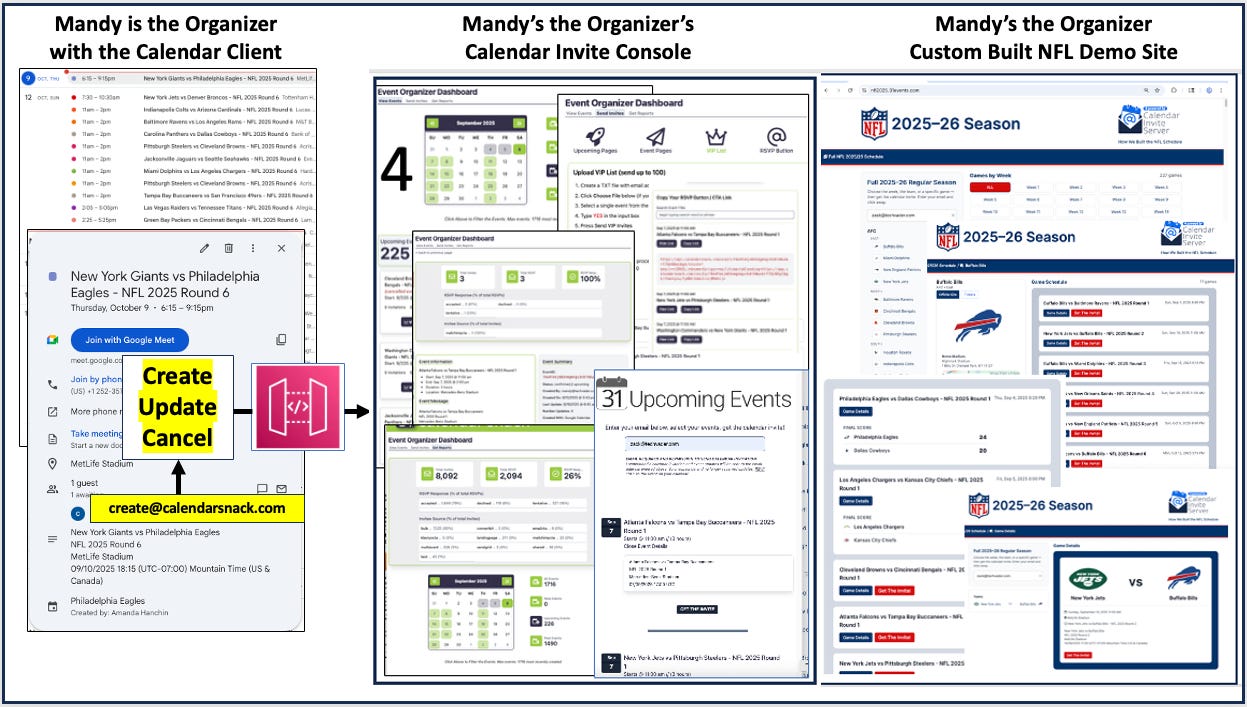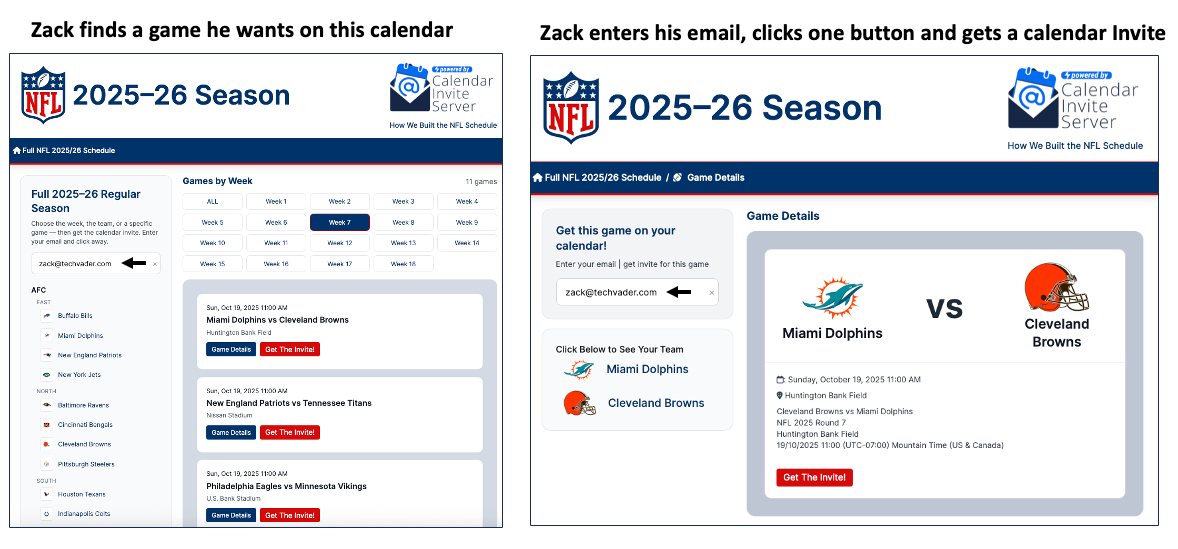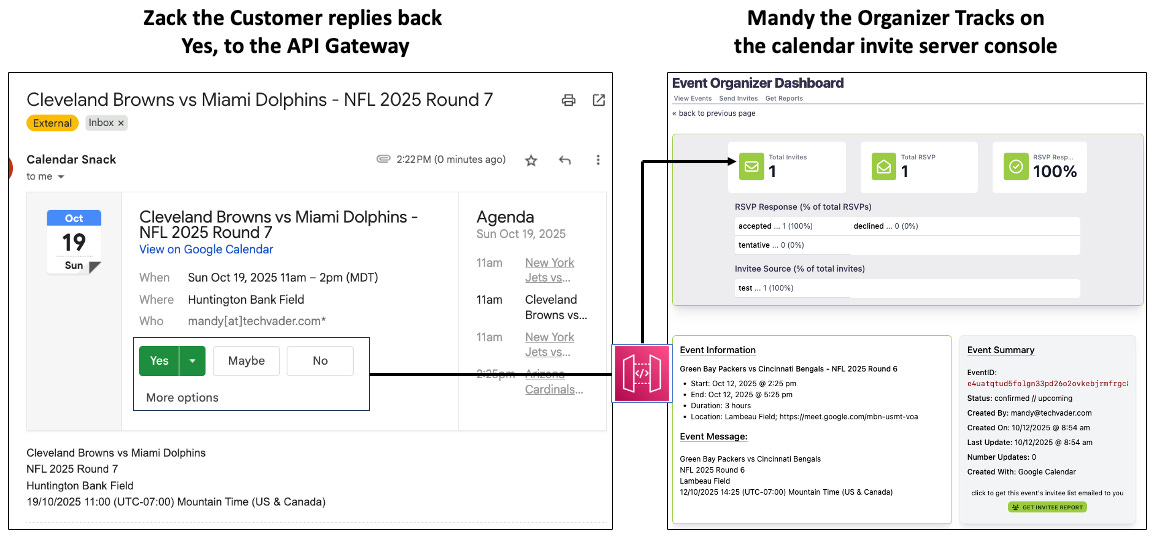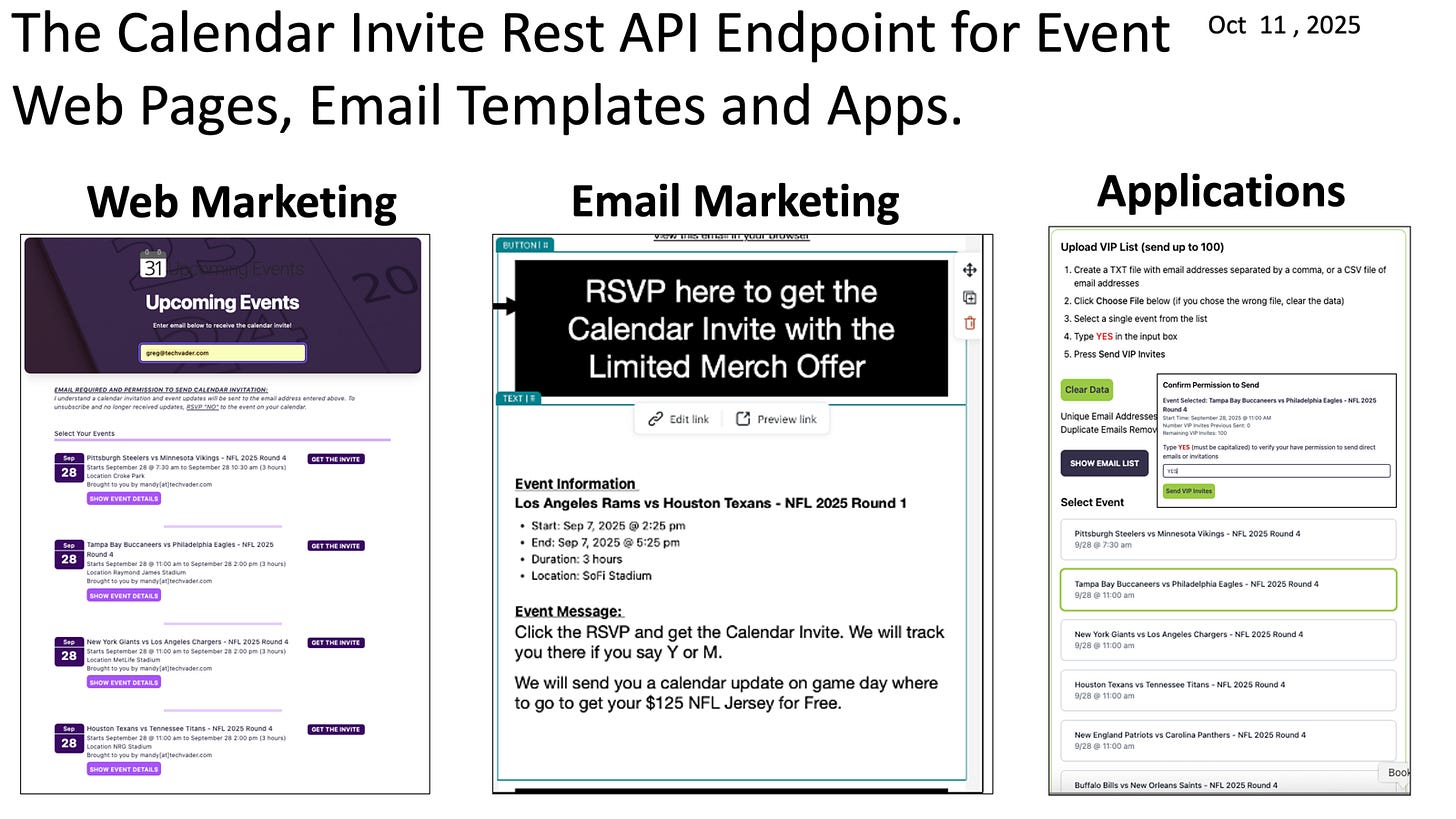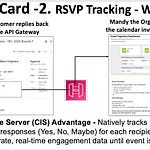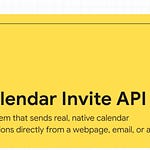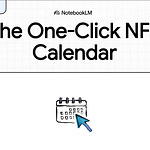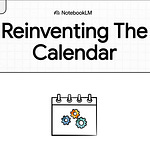Introduction: The Battle for the Customer’s Calendar
In modern digital marketing, one of the most valuable pieces of real estate is a spot on the customer’s personal calendar. It represents a direct line of communication and a commitment of attention that is increasingly difficult to secure. The ultimate objective is not just to place an event on that calendar, but to turn it into an active channel for engagement.
This document compares two distinct methods for achieving this goal: the traditional “Add to Calendar + RSVP Form” and the modern “Calendar Invite Server.”
We will break down how each method works for both the event organizer and the customer, revealing why the server-based approach represents a significant advantage for today’s marketers.
The goal is to secure a spot on the Customer’s calendar, track the calendar invite responses, and have a conversation through Calendar Invite Updates.
By understanding the mechanics and limitations of each method, it becomes clear how one creates a simple, one-time marker, while the other builds a dynamic and lasting connection.
1. The Traditional Method: “Add to Calendar + RSVP Form”
The traditional approach is a familiar but fragmented process. It requires the customer to navigate a series of disconnected steps to both register for an event and add it to their personal calendar.
For the organizer, it involves juggling multiple tools to create the buttons, host the forms, and manage the data, which often remain separate.
The Customer Experience
For the customer, the process is multi-layered and can feel cumbersome, often leading to drop-off before completion. The typical journey involves:
Clicking a button on a webpage or in an email, such as “Add to Calendar.”
Being redirected to a separate landing page to download a static calendar file or fill out a registration form.
Filling out a separate RSVP form to confirm their attendance, which is disconnected from the calendar event itself.
The Organizer’s Workflow
The organizer’s side is equally complex and fragmented. It requires logging into and managing multiple platforms to generate the necessary components—one tool for creating “Add to Calendar” buttons and another for building and managing the separate RSVP forms. These pieces must then be bolted together for each marketing campaign.
The primary limitation of this method is that it creates a “one-way, one-time data drop.” Once the customer downloads the static file, there is no persistent connection. The organizer cannot push updates or track engagement directly through the calendar event.
2. The Modern Method: The “Calendar Invite Server” (CIS)
The Calendar Invite Server (CIS) method streamlines this entire process into a single, integrated workflow. It treats the calendar event itself as the primary vehicle for communication and data collection. Let’s explore this using the story of Mandy the Organizer and Zack the Sports Fanatic Customer.
The Organizer’s Workflow (Mandy)
Mandy wants to offer NFL schedules on her website to engage customers. With a CIS, her workflow is managed almost entirely from the calendar client she already uses every day.
The same data in Mandy’s CIS organizer account is presented on her NFL site, as it uses the same REST API to pull data for both her Calendar Invite Server Console and her NFL promotions site, which builds out the display pages and in the NFL site generates the codes for the Calendar Invite REST API that sends and tracks the calendar invites in one click for the individual games.
Load Events: She first downloads the team’s ICAL schedules from a third-party source, imports those files into her business calendar (e.g., Google Calendar), and then performs a crucial deduplication step to ensure each game is only listed once.
Send to Server: She forwards these events from her calendar to the Calendar Invite Server’s designated email address (
create@calendarsnack.com). This single action makes the events available for her customers.Manage from Calendar: To create, update, or cancel an event, she edits the entry in her own calendar. The act of saving the event is what resends the update to the server’s inbound processor, which then pushes the changes to all customers who have accepted the invite. In addition, update all data in the Console and NFL pages, as they both use the same data hooked to the same APIs.
Track Results: Mandy logs into the Calendar Invite Server dashboard to see real-time RSVP data (Yes, No, Maybe), response rates, and other engagement metrics for each event.
The Customer’s Experience (Zack)
Zack, an NFL fan, visits Mandy’s NFL website and finds the process incredibly simple and direct.
Select & Submit: He browses the game schedule, selects a game he’s interested in, and enters his email address.
Receive Invite: He instantly receives a native calendar invitation directly in his email inbox and calendar application.
Respond Instantly: He can respond with a single click—” Yes,” “No,” or “Maybe”—from within his calendar. No forms, no redirects.
Get Automatic Updates: If Mandy updates the game time or adds a special merchandise promotion to the event description, the event on Zack’s calendar is updated automatically.
This seamless experience sets the stage for a powerful, side-by-side comparison of the two methodologies.
3. Head-to-Head Comparison
The differences between the two methods become most apparent when compared directly across key features. The Calendar Invite Server consistently provides a more integrated, efficient, and user-friendly experience.
Attendee Action
Calendar Invite Server (The Winner) -A simple, one-click “Yes, No, Maybe” response directly within their calendar or email client.
“Add to Calendar” + RSVP Form (The Loser) - A multi-step process: clicking a button, being redirected, and filling out a separate form.
Event Updates
Calendar Invite Server (The Winner) -Changes are seamlessly and automatically pushed directly to the attendee’s calendar, keeping it up to date.
“Add to Calendar” + RSVP Form (The Loser) -Non-existent. This method requires a new email blast, which forces users to update their own calendars manually.
Organizer Workflow
Calendar Invite Server (The Winner) -Simple and integrated. The entire event lifecycle is managed from the organizer’s own familiar calendar client to the REST API of the Calendar Invite Server Pipeline.
“Add to Calendar” + RSVP Form (The Loser) -Complex and fragmented. Requires logging into multiple platforms to generate buttons and manage separate RSVP forms.
Communication
Calendar Invite Server (The Winner) -Establishes a direct, two-way communication channel to the attendee’s calendar for the life of the event.
“Add to Calendar” + RSVP Form (The Loser) -Creates a one-way, one-time data drop. The customer downloads a static file, so there is no persistent connection.
4. The Marketing Advantage: Why the CIS Method Wins
For a digital marketer, the Calendar Invite Server method is more than just a convenience; it’s a strategic tool for building deeper customer relationships. The key advantages include:
Direct Communication Channel. The CIS establishes a persistent, two-way connection directly to the customer’s calendar. This allows the organizer to push updates, share promotions, and maintain engagement for the life of the event. It’s best to “think of it as the ‘Modern Day’ equivalent of the Magnet that vendors give out for your favorite teams with a branded logo on it.” The calendar entry becomes a dynamic marketing asset that lives with the customer.
Superior User Experience. The simple, one-click process removes friction and significantly increases the likelihood that a user will add an event to their calendar. This seamless flow is a primary method for “gathering more customers through the use of email data collection,” as the brand provides immediate value (the calendar invite) in exchange for the customer’s email address. A positive user experience becomes the first step toward acquisition and loyalty.
Actionable Data & Segmentation. By tracking RSVP responses (Yes, Maybe, No) in a central dashboard, the organizer can gather valuable data on customer interest. This allows for intelligent segmentation and highly targeted follow-up. For example, Mandy can edit the original event in her calendar and build a new calendar invitation “that includes the promotional Jersey and a Booth Number in the message body to those who responded with a Y or M from the first calendar invite.” This makes her communications more relevant, timely, and effective.
5. Conclusion: Owning the Calendar Channel
While both methods share the initial goal of placing an event on a user’s calendar, their capabilities and strategic value diverge dramatically. The traditional “Add to Calendar + RSVP Form” completes its task and offers little more, functioning as a one-time data drop.
In contrast, the Calendar Invite Server approach transforms that duplicate calendar entry into a living, two-way communication channel. It simplifies the workflow for the organizer, enhances the customer experience, and provides actionable data for modern, relationship-focused marketing. For marketers who understand that the real goal is not just to be remembered but to stay connected, the CIS method is the clear and definitive winner.


